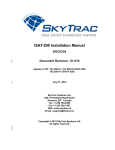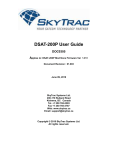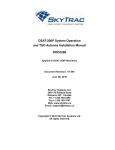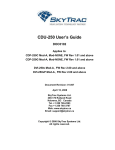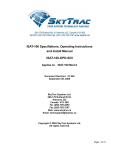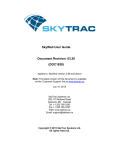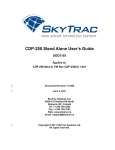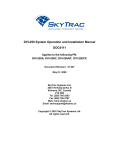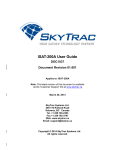Download DVI-300 Stand Alone User`s Guide
Transcript
DVI-300 Stand Alone User’s Guide DOC0499 Applies to: DVI-300, FW Rev 04.08.00 Document Revision: 01.001 December 16, 2010 SkyTrac Systems Ltd. #200-170 Rutland Rd North Kelowna, BC Canada Tel. +1 (250) 765-2393 Fax +1 (250) 765-3767 Web: www.skytrac.ca Email: [email protected] Copyright © 2010 SkyTrac Systems Ltd. All rights reserved. SkyTrac Systems Ltd. Document Revision History Rev ECO Page Description Date Author Approval 01.000 - Initial Release Aug 13, 2009 C. Bryson M. Nordine 01.001 Added ECO control Dec. 16, 2010 Y. Liu T. Ratch 354 Proprietary Notice: The Information contained in this document is proprietary and confidential to SkyTrac Systems Ltd. Document Rev. 01.001 DVI-300 Stand Alone User’s Guide Restricted Proprietary and Confidential Information Page 2 of 14 SkyTrac Systems Ltd. Table Of Contents 1 Introduction ...................................................................................................................4 1.1 1.2 1.3 1.4 1.5 2 Acronyms .................................................................................................................4 Scope .......................................................................................................................4 System Requirements ..............................................................................................4 Description ...............................................................................................................4 Features ...................................................................................................................5 General ...........................................................................................................................6 2.1 Setup .......................................................................................................................6 2.1.1 DVI-300 Models ................................................................................................6 2.2 Configuration............................................................................................................6 2.3 Diagnostics ..............................................................................................................6 2.3.1 Power-On Indicator ...........................................................................................6 3 Operation .......................................................................................................................7 3.1 Indicators .................................................................................................................7 3.2 Error Indication.........................................................................................................8 3.3 Dialling .....................................................................................................................8 3.4 Generating DTMF Tones during a Phone Call .........................................................9 3.5 Speed Dial ...............................................................................................................9 3.5.1 Programming Speed Dial Numbers ..................................................................9 3.5.2 Redial................................................................................................................9 3.6 Receiving a Satellite Phone Call ............................................................................10 3.7 Audio Parameters ..................................................................................................10 3.7.1 Call Volume Control ........................................................................................11 3.7.2 Ringer Volume ................................................................................................11 3.7.3 Mic Mute .........................................................................................................11 3.7.4 Side Tone Gain ...............................................................................................11 3.7.5 Ringtone Selection ..........................................................................................11 3.8 Brightness Control .................................................................................................12 3.8.1 Indicator Brightness ........................................................................................12 3.8.2 Backlighting Brightness...................................................................................12 3.9 Text Messages.......................................................................................................12 3.9.1 Programming Text Messages .........................................................................12 3.9.2 Sending Text Message ...................................................................................12 3.10 ISAT Emergency Mode ..........................................................................................13 3.11 Access Control .......................................................................................................13 3.11.1 Enabling PIN ...................................................................................................13 3.11.2 PIN Description ...............................................................................................14 3.11.3 Entering PINS in DVI ......................................................................................14 Document Rev. 01.001 DVI-300 Stand Alone User’s Guide Restricted Proprietary and Confidential Information Page 3 of 14 SkyTrac Systems Ltd. 1 1.1 INTRODUCTION Acronyms Acronym STS DVI ISAT CDP 1.2 Description SkyTrac Systems Ltd. Dispatch Voice Interface SkyTrac’s Flight Following Unit. Cockpit Display Panel Scope This document provides instructions on the operation of the features of SkyTrac System’s Dispatch Voice Interface (DVI-300). 1.3 System Requirements An installed ISAT-200 (loaded with FirmWare that supports the DVI-300) including antenna and an installed DVI-300 are required. An open view of the sky by the ISAT antenna is required for communications. Please contact STS Client Services for software version requirements for peripherals if updating a peripheral from an ISAT-100 to an ISAT200 installation 1.4 Description The DVI is an interface to the ISAT that enables the user to send and receive satellite phone calls. The DVI also enables the user to send pre-programmed text messages. Document Rev. 01.001 DVI-300 Stand Alone User’s Guide Restricted Proprietary and Confidential Information Page 4 of 14 SkyTrac Systems Ltd. 1.5 Features International number dialling. Last number redial. 9 Pre-Programmed Speed Dial Numbers. 125 User programmable Speed Dial Numbers. Volume Control (10 levels). Side Tone volume control (6 levels) DTMF Tone dialling for Automated Phone Menus Up to 10 Pre-Programmed Text Messages. Indicator to notify user of ISAT Data Delay. Emergency switch (push button or toggle) to trigger the ISAT emergency mode. Indicator brightness controls for bright (day) and dim (night) modes. PIN Number Access Control Feature Document Rev. 01.001 DVI-300 Stand Alone User’s Guide Restricted Proprietary and Confidential Information Page 5 of 14 SkyTrac Systems Ltd. 2 GENERAL 2.1 Setup The DVI-300 communicates with the ISAT through a RS485 connection. Refer to the document DVI-300 System Operation and Installation Manual for details on the installation of DVI-300. The DVI-300 does not process or provide audio signals. Audio signals are provided directly from the ISAT to aircraft audio systems. Refer to the ISAT System Installation Manual for details on how to setup the base audio levels during installation. 2.1.1 DVI-300 Models Type Part Numbers Description Green backlighting with locking toggle emergency switch Compatibility * 101-200-01, 101-200-02 DVI-300C 105-300-01 DVI-300A 105-300-02 NVIS A backlighting with locking toggle emergency switch 101-200-01, 101-200-02 DVI-300CP 105-300-03 Green backlighting with push button emergency switch 101-200-01, 101-200-02 DVI-300AP 105-300-04 NVIS A backlighting with push button emergency switch 101-200-01, 101-200-02 2.2 Configuration The DVI-300 is connected using the RS485 link and functions as an intelligent interface with calling and messaging features and support for the CDU-300 when combined with a CDP300. 2.2.1.1.1.1.1.1 2.3 Diagnostics 2.3.1 Power-On Indicator When the DVI-300 powers up, the three indicators briefly illuminate once to indicate start-up and initialization (unless in programming mode). Document Rev. 01.001 DVI-300 Stand Alone User’s Guide Restricted Proprietary and Confidential Information Page 6 of 14 SkyTrac Systems Ltd. 3 OPERATION Caution: While in a voice call the ISAT is unable to send position reports. All position reports are queued and delivered when the call is finished. Users should limit the length of the voice call in order to allow position reports to be transmitted in a timely manner. 3.1 Indicators The DVI-300 has three Indicators that provide visual feedback to the users during its operation. The following table summarizes the behaviour of the indicators for different actions. The ‘Msg In’ indicator is used in the DVI-300 standalone mode to indicate communication failure with the ISAT. Indicator Activity Activity Activity Action Indicate a key press Operation Unsuccessful, Cancelled by user, or not permitted/ error ISAT Emergency Behaviour Blinks once Blinks four times rapidly stays on solid after blinking all indicators in rotation (DVI standalone operation only) Activity, Activate the ISAT Emergency mode, When ISAT emergency is activated Data delay, or if the user attempts to use the DVI all indicators blink in rotation briefly, Msg In keypad when the Emergency mode is (DVI standalone mode only) active Activity Call placed/ Call Answered Turns ON solid until the call is terminated Activity Brightness increased/decreased Blinks twice slowly Activity Volume increased/decreased Blinks twice slowly Activity Text message sent Blinks twice slowly Activity Waiting for PIN number entry Blinks eight times slowly Data delay ISAT – Satellite communication Turns ON solid until the failure – or position reports queued communication is restored or queued reports have been sent Data delay RS485 communication link failure or Data delay blinks four times (for 3 and Msg In if the user attempts to use the keypad times in a row) and then Msg-In goes while RS485 communication is not on solid available Msg In New Email - Not applicable to DVI standalone operation Document Rev. 01.001 DVI-300 Stand Alone User’s Guide Restricted Proprietary and Confidential Information Page 7 of 14 SkyTrac Systems Ltd. 3.2 Error Indication If an error occurs in the operation of the DVI-300, the Activity indicator will rapidly flash four times to indicate an error and clear all key presses. For example, if the user attempts to dial * 8 SEND (Fctn 8 SEND) the DVI-300 Activity indicator will flash four times and clear its memory of the keys pressed, thus allowing the user to start again fresh. Note: There is a 60 second timeout when pressing keys. If the timeout elapses between key presses, the Activity indicator flashes four times, indicating an error and the DVI-300 resets the keypad as if there have been no key presses. 3.3 Dialling To dial a phone number, simply dial the desired number using the keypad and press the Send Key. The Activity indicator will flash once to indicate when each digit of a number has been entered. Repeat this process until all the numbers have been entered. When finished, press the Send key to initiate the call. If a mistake has been made press # or * once to cancel previous entries and start fresh. A long distance number must be dialled regardless of the location of the aircraft. To place a call, dial an international number: International Direct Dialling (IDD) prefix of the country you are calling from (00 for Iridium) then the destination country code (1 for Canada and the US), followed by the area code and local number. For example, to call SkyTrac Systems office, dial: 00 1 250 765 2393 Once a call has been initiated, the Activity indicator will stay on solid indicating the ISAT is initiating the call. It may take a moment for the ISAT to initiate the call if it is already busy communicating with the Iridium network. To hang-up simply press the Send key again. Once the call is initiated by the ISAT, the user will hear a periodic beep. If the call fails, the user will hear beeps to indicate the signal was lost. If the signal is lost, the call will end and the Activity indicator will go out. The user will hear a normal telephone ring when the call connects. If you make a mistake dialling, pressing * or # once to clear the entries and you can begin dialling again. Document Rev. 01.001 DVI-300 Stand Alone User’s Guide Restricted Proprietary and Confidential Information Page 8 of 14 SkyTrac Systems Ltd. 3.4 Generating DTMF Tones during a Phone Call The DVI-300 can generate DTMF tones, enabling the user to access automated voice menus. They will hear the DTMF tones over the headset. DTMF Tones can only be generated once a phone call is already in progress. In order to generate a DTMF tone, press the desired key for each tone desired. For example to send the tones for numbers 5768# to an automated menu, press 5768# in sequence when the call is in progress. Allow the Activity indicator to flash twice between successive digits. 3.5 Speed Dial The user has the option to program up to 9 Speed Dial numbers (corresponding to keypad numbers 1 through to 9) via the key pad and up to 125 via the SkyWeb application (see the user’s SkyWeb Program Manager or their designate to get these entered). Note: Position 0 is used for redial purposes and cannot be programmed as a speed dial. Simply press the one digit speed dial number and press the Send key to dial the preprogrammed number. If a mistake has been made press # or * once to cancel. If more than one number is entered the DVI-300 will treat the number as a regular phone number dialling sequence and attempt to dial the number when the Send key is pressed. Once the call is initiated the DVI-300 operates the same as it does for a manual dialled call. 3.5.1 Programming Speed Dial Numbers Speed dial numbers can be assigned using the DVI-300 keypad. To assign a phone number to a key (for keypad 1 through to 9), press * 2 (FCTN 2). Then enter the speed dial phone number to be assigned. Once the phone number is entered, press the * (FCTN) key again followed by the number key to which the speed dial number is to be assigned. The Activity indicator will flash once for each of the key presses except for last key press. The Activity indicator will flash twice at the last key press to indicate a successful programming assignment. For example to assign the phone number 001 300 765 2393 to speed dial key 3, press *20012507652393*3 3.5.2 Redial Pressing the ‘0’ key followed by the Send key will place a call to the last number dialled. If there is no last number stored, the DVI-300 will flash Activity indicator four times indicating an error. Last number dialled is erased when the DVI restarts. Document Rev. 01.001 DVI-300 Stand Alone User’s Guide Restricted Proprietary and Confidential Information Page 9 of 14 SkyTrac Systems Ltd. 3.6 Receiving a Satellite Phone Call In order to dial the ISAT from the ground, the user must dial an international number. The country code for the Iridium Satellite network is 8816 or 8817. To dial an international number, dial the International Direct Dialling (IDD) prefix of the country you are calling from (011 for Canada and the US) then the destination country code (8816), followed by the ISAT’s number. Example: 011 8816 3101 0616 When a call comes in to the ISAT, the DVI Activity indicator will illuminate and an audible ring will be heard on the headset. To answer the call, press the Send key. When finished, press the Send key again to hang up. If the ground user hangs up, it may take the Iridium system a few moments to detect the hang up before the ISAT will automatically end the call. The Activity indicator will go out when the ISAT hangs up the call. It may take several attempts to connect to the Iridium network when dialling the ISAT from the ground. If the first attempt fails, try again. 3.7 Audio Parameters The complete list of settable ISAT-200 audio parameters is: 1. 2. 3. 4. 5. 6. 7. 8. Mic DC bias (completed during install) Mic Input Level (completed during install) Mic Volume (changed on the ISAT itself) Call Volume (10 levels) Ringer Volume (10 levels) Mic Mute (On/Off) Side Tone Volume (6 levels) Ringtone Selection (6 tones available) Two of these parameters must be set to properly install the ISAT-200. They are Mic DC bias and Mic input level. Once set, these parameters will not typically be changed. See the ISAT-200 Installation guide for further details. The other parameters, Call Volume, Ringer Volume, Mic Mute, Side Tone Gain, and Ringtone selection can be altered by the user in the course of normal use. The following section explains how to change these settings on the DVI-300 itself. See the ISAT-200 User’s Manual for instructions on setting these parameters on the ISAT itself. Note: These parameters retain the last value set in the course of normal use. Document Rev. 01.001 DVI-300 Stand Alone User’s Guide Restricted Proprietary and Confidential Information Page 10 of 14 SkyTrac Systems Ltd. 3.7.1 Call Volume Control The DVI-300 allows the user to change the volume only when a call is in progress. The DVI300 has ten volume settings. To change the volume during a call simply press * 6 (FCTN 6) to increase the volume, or * # (FCTN #) to lower the volume. Note: It may take up to 30 seconds for the volume to adjust 3.7.2 Ringer Volume The ringer volume also has ten settings and can be adjusted when the user is not on an active call. The user must use the same key presses as those used for call volume. 3.7.3 Mic Mute The microphone can be muted only when a call is in progress. Selecting * 5 (FCTN 5) will toggle between muting the call and reverting back to normal. 3.7.4 Side Tone Gain The side tone gain has 6 levels of adjustment. Selecting *4 (FCTN 4) will increase the level and * 0 (FCTN 0) will reduce it. 3.7.5 Ringtone Selection Connect your headset to the ISAT. As each choice is selected then the associated Ring Tone will sound for one second in the headset. If nothing is heard after toggling through a selection, increase the Ringtone Volume and then try again. If no setting results in an audible ring tone, please double check the wiring and ensure the procedures in the ISAT Installation Manual have been followed completely. Parameter Call Volume (on active call) Ringer Volume (no active call) Mic Mute (on active call) Side Tone Gain Ringtone Selection (no active call) Method FCTN 6 - Increase FCTN # - decrease As above FCTN 5 - Toggles between mute and un-mute FCTN 4 - Increase FCTN 0 - Decrease FCTN 5 + Ringtone Number (1-6) Document Rev. 01.001 DVI-300 Stand Alone User’s Guide Restricted Proprietary and Confidential Information Page 11 of 14 SkyTrac Systems Ltd. 3.8 Brightness Control 3.8.1 Indicator Brightness The DVI-300 indicators operate in two brightness modes - bright (day) mode and dim (night) mode. The DVI-300 can be wired to the aircraft dimmer bus (see note below) so that it can switch seamlessly between these modes based on the aircraft cabin lighting or the aircraft dimmer bus. When the dimmer bus is off, the DVI-300 is in bright (day) mode. The brightness level of the indicators can also be changed manually at anytime. To change the brightness at any time manually, simply press * 1 (Fctn 1) to increase the brightness, or * 7 (Fctn 7) to decrease the brightness. Refer to DVI-300 Wiring Installation Diagram and DVI-300 System Operation and Installation Manual for details regarding connecting the DVI-300 to the aircraft dimmer bus. Note: Currently SkyTrac Client Services ([email protected]) will need to be contacted to configure the dimmer bus on the DVI-300 standalone. 3.8.2 Backlighting Brightness Efficient and long lasting LED illumination enables the backlighting to be on all the time. When the DVI-300 is connected to the aircraft dimmer bus, the DVI-300 backlighting follows the aircraft dimmer bus voltage. If the aircraft dimmer bus is not connected to the DVI-300, or the aircraft dimmer bus voltage is off (for day use), the backlighting is on at full brightness. This ensures that regardless of the ambient lighting conditions, the keys will remain visible. Note that the Indicator brightness is separately controlled. 3.9 Text Messages 3.9.1 Programming Text Messages The user has the option of pre-programming up to 10 DVI text messages (0 through to 9) to a text message list. Text messages can be programmed using FlightTrac Suite. Refer to the FlightTrac User Manual to learn how to program text messages 3.9.2 Sending Text Message To send a Text Message, press # and the number of the desired text message. Then press the Send key to send the message – the Activity indicator will flash twice to indicate that the message has been sent. If a mistake has been made press # or * once to cancel. If more than one number is entered after the # key, the Activity indicator will flash four times to indicate an error and clear previous entries. Document Rev. 01.001 DVI-300 Stand Alone User’s Guide Restricted Proprietary and Confidential Information Page 12 of 14 SkyTrac Systems Ltd. 3.10 ISAT Emergency Mode The ISAT Emergency mode (ISAT EMERG) is activated or cancelled (to return to Normal “NORM” mode) via a locking toggle switch, or pushbutton switch on the DVI-300 front panel as described below. DVI-300 – switch type Activate ISAT Emergency Cancel ISAT Emergency Locking toggle switch Place the locking toggle switch into Place the locking toggle switch into (applies 300C) to DVI-300A, Pushbutton DVI- the “ISAT EMERG” position (up) the “NORM” position (down) switch Press and hold the pushbutton for Press and hold the pushbutton for a (applicable to DVI-300AP, DVI300CP only) a minimum of 3 seconds or longer (while operating in Normal mode) minimum of 3 seconds or longer (when operating in Emergency mode) Both Toggle switch and Push button switch models will blink the 3 DVI indicators in rotation then turn the activity indicator on Solid when the ISAT Emergency mode is activated and the DVI is operating as a standalone device. . During ISAT emergency mode operation, DVI key presses are ignored, and cause the 3 indicators to blink in rotation. The ISAT does not allow voice calls or text messages to be sent while in ISAT emergency mode. If the user is in a voice call when ISAT Emergency is triggered, the ISAT will end the voice call in order to send emergency position reports. Switching the ISAT back to Normal mode (Norm) ends the emergency condition. The DVI activity indicator blinks twice to confirm when the ISAT has returned to Normal Mode. 3.11 Access Control 3.11.1 Enabling PIN To activate the PIN feature in your DVI-300, please contact Skytrac Systems. If the PIN feature is not activated for your installation then there are no restrictions to calling or messaging and all users have full access to Sat Phone calling, and DVI text messaging. Note: The following description is valid only if PINS are activated in the DVI-300 The DVI-300 supports restricted access to the calling and text messaging features of the ISAT by the use of a PIN number. PIN numbers could be used for the following purposes: 1. To prevent unauthorized access of calling and text messaging 2. To determine or track the call usage (duration) of each DVI-300 user. Document Rev. 01.001 DVI-300 Stand Alone User’s Guide Restricted Proprietary and Confidential Information Page 13 of 14 SkyTrac Systems Ltd. 3.11.2 PIN Description The DVI-300 supports a maximum of 400 distinct PINS – i.e. the DVI-300 will be able to identify up to a maximum of 400 distinct users. The PIN length can be 4, 5 or 6. This length applies to all the PINS used in the DVI-300. For each PIN, an access level can be configured to • • • Enable/Disable incoming calls Enable/Disable outgoing calls Enable/Disable outgoing text messages When the PIN feature is activated, a default access level must be set for the DVI-300. This default access level will be used if no PIN is entered in to the DVI-300 or when an invalid PIN is entered to the DVI-300. For example, if the default access level is set to disable outgoing calls and messaging, then a user cannot make an outgoing call unless they enter a PIN with an access level to make outgoing calls. 3.11.3 Entering PINS in DVI When the DVI-300 starts-up, it will prompt the user to enter a PIN by blinking the activity light 8 times. If a valid PIN is entered then the activity light will blink twice indicating a valid PIN. If an invalid PIN is entered, then the activity light will flash four times rapidly indicating an error. If a PIN is not entered within the 8th flash, the DVI-300 will use the default PIN. To enter a PIN after start-up, press *8 followed by the PIN and then press Send. If a valid PIN is entered then the activity light will blink twice. If an invalid PIN is entered, then the activity light will flash four times. A PIN has to be entered every time the DVI-300 powers-up. At any time, the DVI-300 can be put to use the default access level by entering *8 followed by 0 and then Send. The activity light will blink four times indicating that the default access level is used. Document Rev. 01.001 DVI-300 Stand Alone User’s Guide Restricted Proprietary and Confidential Information Page 14 of 14















